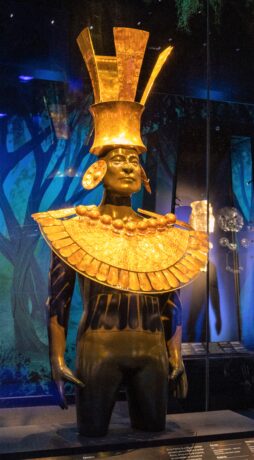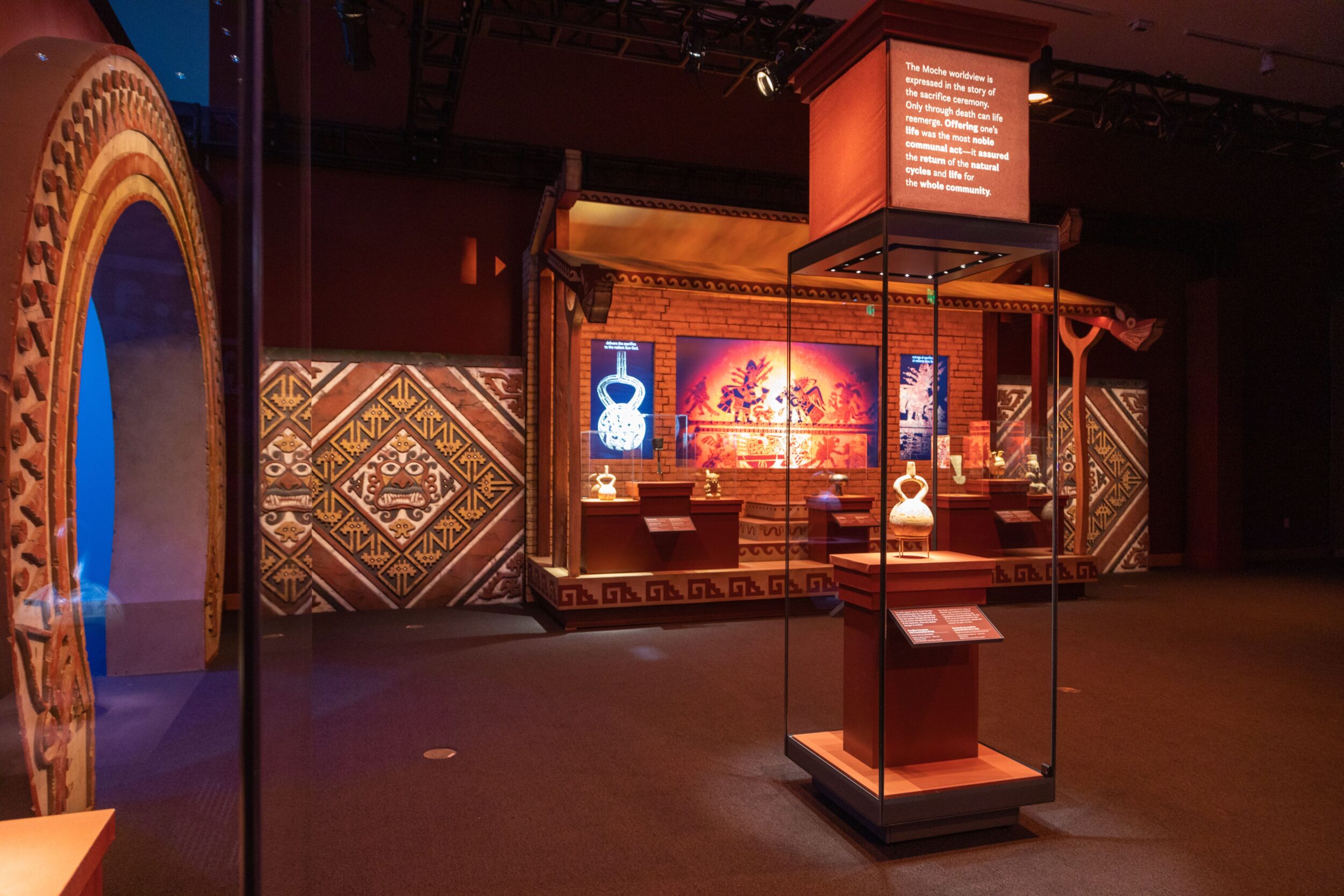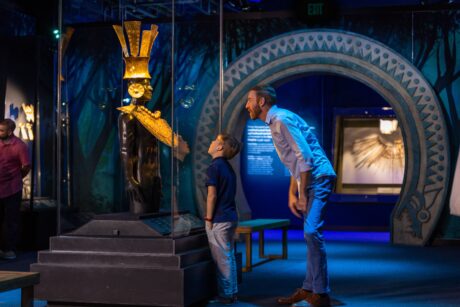
Describing it as the “sweat of the sun,” the Incas revered gold as far more than a symbol of wealth and power. To them, the glittering metal was a gift bestowed directly from the gods that radiated mystical, restorative powers from its shimmering surface.
An ancient myth? Perhaps. Still, it’s one that visitors to Machu Picchu and the Golden Empires of Peru will readily understand. Named after a 15th-century Incan citadel in the Peruvian Andes, the exhibit, which opened at the Boca Raton Museum of Art, showcases a dazzling collection of 192 gold artifacts crafted by this vanished civilization.
The stunning collection of chalices, bracelets, breastplates, and other objects beckon visitors to dive deep into the world of the Incas. Embarking on their journey, they enter a collection of immersive walk-through galleries that house these artifacts. Taking up virtually the entire museum on two floors, these rooms reflect Incan life and culture in all its complexity and mystery.
Enhancing the transformative power of this experience is a supportive and engrossing lighting design by Lightswitch that features Chauvet Professional fixtures supplied by Murphy Lighting Systems. Positioned on ground supported truss structures that run throughout the exhibit, and are integrated into the exhibit wall system, the lighting design helps to guide visitors as they walk through Machu Picchu, all while captivating their attention through the use of colors, shadows, and gobo patterns.

“For this exhibit, we relied on the Chauvet fixtures for the graphics, scenic lighting, and circulation in addition to creating effects, such as a beautiful underwater look in one of the galleries,” said Lightswitch’s Bradley Malkus, who served as lighting designer and programmer for Machu Picchu. “This exhibit was produced and designed by World Heritage Exhibitions, a division of City Neon Group, and a select group of collaborators that we have worked with on many projects over quite a few years.”
During the design phase of the project, the Lightswitch team was responsible for integrating lighting into the multi-dimensional exhibit, in addition to rendering power distribution design services. Then at the installation, they provided a master electrician, with Malkus onsite to supervise the lighting installation and programming.
Over 400 lighting fixtures were used in the spacious exhibit, roughly two-thirds of them from Chauvet Professional. These included the Ovation P56-FC, COLORado 1 Quad Zoom, COLORado Batten Quad 12, and DMX4 Dimmer Packs. Malkus described how these fixtures worked in conjunction with other creative elements to make Machu Picchu come alive.
 “An important role for lighting in this kind of exhibition is to create an appropriate background that lets the other elements stand out,” he said. “The exhibit designers that I have been working with have been incorporating more and more video into their projects as a way to communicate information to the guests, while keeping traffic flowing. Dealing with the extra light that these displays bring into the galleries is challenging, but the design team is outstanding about working together.
“An important role for lighting in this kind of exhibition is to create an appropriate background that lets the other elements stand out,” he said. “The exhibit designers that I have been working with have been incorporating more and more video into their projects as a way to communicate information to the guests, while keeping traffic flowing. Dealing with the extra light that these displays bring into the galleries is challenging, but the design team is outstanding about working together.
More than a collection of stunning artifacts expertly presented by a cohesive team, Machu Picchu is also a captivating narrative that takes visitors through thousands of years of Andean civilization, culminating with the Incan empire. Lighting plays a pivotal role in helping this narrative unfold. A vivid example is provided in Gallery 4, where a character in that narrative moves into water. The depth of this water becomes progressively deeper as visitors walk through the room. Malkus and the design team convey this sensation effectively by washing the floor with light that becomes darker and darker.
Another example can be seen in Gallery 8, which displays ornamental pieces worn by the Incas. These artifacts are arranged on translucent panels in positions that correlate to where they would be worn on the human body. Lighting is used to create silhouettes behind the panels to give the display a haunting human-like quality. In addition to enhancing the narrative elements of the exhibit, the lighting design had to ensure that each artifact was lit in a manner that reflected its aesthetic qualities, a process that required meticulous attention to detail.
“Artifact exhibit lighting is tricky because you need to light the objects in a way that lets guests examine them thoroughly while providing an environment that is safe for both the objects and the guests,” said Malkus. “Audiences today also expect exhibits like this to be beautiful and dramatic while telling a fantastic story. The lighting for these projects becomes more theatrical all the time—which we love!”
 Thanks to the advent of more compact and efficient LED fixtures, Lightswitch has been able to build lighting into artifact display cases. This provides exhibit producers with more flexibility, allowing them to move displays while still maintaining consistent lighting coverage. It also eliminates the chance of visitors blocking the light source when they gather around a display.
Thanks to the advent of more compact and efficient LED fixtures, Lightswitch has been able to build lighting into artifact display cases. This provides exhibit producers with more flexibility, allowing them to move displays while still maintaining consistent lighting coverage. It also eliminates the chance of visitors blocking the light source when they gather around a display.
Malkus offers kudos to the whole team behind the exhibit. “From World Heritage Exhibitions there were the producers John Norman and Anthony Tann; project managers Christina Wright, Stacy Sidman, and Mike Lewis; master electrician Philip Zammit; as well as our electricians Edgar Olave and Carlos Gonzalez. From Spilt Rock Studios we had exhibit designer Amanda Wambach; and from Design Electronics, Scott Daeng and Felice Taddeo have done excellent work in A/V and show control.”
Gazing upon the exquisite pieces showcased in those displays, Machu Picchu visitors are filled with a sense of awe at the rich history that glitters before them. Its resonant power as moving today as it was in a far-off land many centuries ago, now made even more potent by a transformative lighting design.
Further information from Chauvet Professional: www.chauvetprofessional.com


